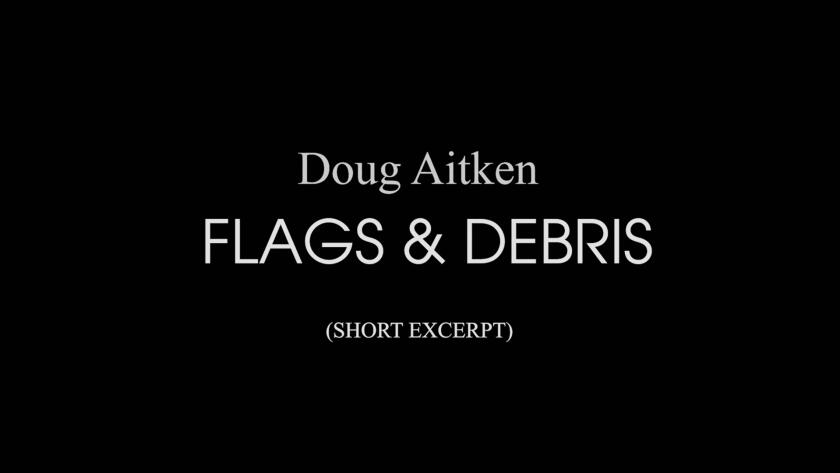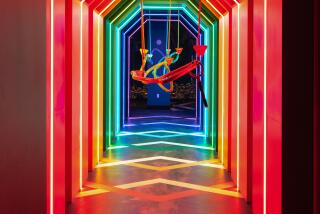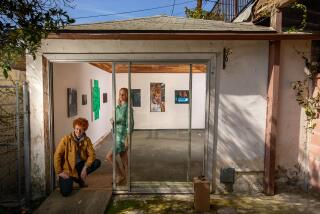Pandemic City: Doug Aitken, L.A. Dance Project and a COVID-19 ‘art encounter’
Plenty of artists and filmmakers have set out to capture empty urban landscapes in moments of COVID-19 isolation, but artist Doug Aitken’s new multiscreen film installation made in collaboration with L.A. Dance Project viscerally engulfs the viewer in the early days of the pandemic.
Aitken’s film, paired with his new fabric works and light box sculptures on view at the Regen Projects gallery exhibition “Flags and Debris,” conjure the acute uncertainty and oddly alluring stillness of that moment.
It was in that quietude last spring that Aitken — who typically produces multimedia works and large-scale installations — began to cut up his old clothing. It’s the first time the artist has worked with fabric, and the resulting hand-sewn tapestries suggest slow-paced quilting and domestic interiors, a stark contrast to his previous immersive earth works.
The tapestries are a central character in the film. Aitken partnered with L.A. Dance Project, cocooning performers in the fabric works so they were completely obscured. He then filmed them moving through deserted locations throughout L.A. In one scene, a pulsing bundle of black fabric lurches down an abandoned sidewalk, like an inky tumbleweed. In another, a fabric-wrapped figure rises like an apparition. The ominous sound of howling wind fills the gallery.
Next week Aitken will launch a wheat-pasting campaign from downtown L.A. to the Westside, with posters featuring QR codes that send passersby to excerpts of the film — an “egalitarian art encounter,” as the gallery put it.
In the meantime, eight of the fabric works, each offering abstract configurations of text, are on view in the gallery. Some boast simple messages such as “Nowhere/Somewhere” and “Data Mining,” the lettering breaking apart like bits of digital detritus. Others include published text, such as a line from Joan Didion’s “The White Album.”
Two of Aitken’s light boxes depict sweeping aerial shots of the city at night; another, a three-part panorama of COVID-19 street life as if shot from a moving car, shows a frenetic, at times blurry patchwork of empty strip malls, blank billboards, shuttered stores.
Ultimately, however, the exhibition feels hopeful. The film depicts L.A.’s glimmering lights at night intercut with a slowly rising fist. The message: There is beauty amid devastation, movement amid stillness. There is resilience, even in the darkest of times.
“Making this was my vessel to survive,” Aitken said in this edited conversation.
You’ve never worked with fabric before. What sparked that impulse?
This experience we’ve all gone through is like a tidal wave; and when that wave started cresting in March and April, and we were all in lockdown, I started looking around me. I started making these personal challenges. And one of them was: How can you create with what’s immediately around you? Just the simplest ingredients. And I started looking at old clothes, old materials that were laying around. And almost in a hypnotic way, I started to cut them and collage them and transform them into words and language. I’ve always been attracted to collage. But I wasn’t using paper and images. I was using the fabric of my life to make these flags and banners, but also objects for protection and shelter. And it kind of grew from that.
The film, shot in deserted urban locations at the start of the pandemic — under a freeway, by the L.A. River, at the beach at night — is both site-specific and time-specific. What role did these locations play?
I was really interested in this idea that the city, for a brief period of time, had become this blank, concrete canvas. And all these spaces, which were once filled with activity, were suddenly empty and dormant. And in my imagination, I visualized that all these spaces that were sort of neglected and empty could be activated, could come to life. And we could perform in them, create these choreographies, and that would become the DNA for the film.
The choreography is at times jerky and anxious, at times sluggish and despondent, sometimes even ethereal. What were you and L.A. Dance Project going for?
The whole project was so organic. There was no master plan; it was completely intuitive. Around September I felt it would be so interesting if people could use these pieces we’ve been making by hand. What if bodies could be inside of them, activating them? But I didn’t want a piece about a man or a woman; it wasn’t about a story. It’s more about us, a kind of abstract portrait of this condition we’re in as a society. Is there a way that human movements, whether jerky and violent or slow and harmonious, could speak to that?
You’ve referred to the dancers in the film as “liquid sculptures.” What do you mean?
I saw the dancers not so much as being about the narrative of race or gender or age, but instead I saw them as these kind of vessels that could expand and contract and express different nuances within the landscape they were in.
What’s the point of the poster campaign?
I was thinking about how to open up the body of work and to share it with a wider audience. The initial way you’d answer that is digital, but I thought maybe we can take a very analog approach toward sharing the work. Even someone who knows nothing about it and just stumbles across it. We created these posters made to be wheat-pasted across the city — very random places — and the idea was that someone could be sitting at a bus stop, log on to the QR code, and suddenly their phone or tablet would activate into this experimental film, this artwork. I love the idea: Can we take art outside of the galleries and museums and broaden its bandwidth?
There’s a sense of disjointedness throughout the show — broken up lettering on the tapestries, puzzled-together urban photography in the light boxes, juxtaposed imagery in the film. What was your intent?
I think that fragmentation is the new narrative, in a way. We’ve kind of grown into a world where we’re so inundated and saturated in information that it’s hard for us to find the straight story. It’s hard for us to find a line to follow. And this body of work very much came out of that landscape. 2020, and from what we’ve seen of 2021 — it’s kind of a new era that we’re living in. And perhaps this work is trying to share [that idea] with people, to create a bridge to help us navigate that, help us understand where we are and where we’re potentially going.
Where are we going, in your opinion?
We’re at this big paradigm shift where we need to really look at how culture can work and how we can share it. How the dialogue can exist outside of how it’s been in the past. Because the past is very, very static. And I think that’s part of the hope that we have right now — that we can use this moment of disruption to create new models, to create things that are more broad, that have more depth to them and are more inclusive in a way.
'Doug Aitken: Flags and Debris'
Where: Regen Projects, 6750 Santa Monica Blvd., Los Angeles
When: By appointment, through March 13
Info: www.regenprojects.com
More to Read
The biggest entertainment stories
Get our big stories about Hollywood, film, television, music, arts, culture and more right in your inbox as soon as they publish.
You may occasionally receive promotional content from the Los Angeles Times.












